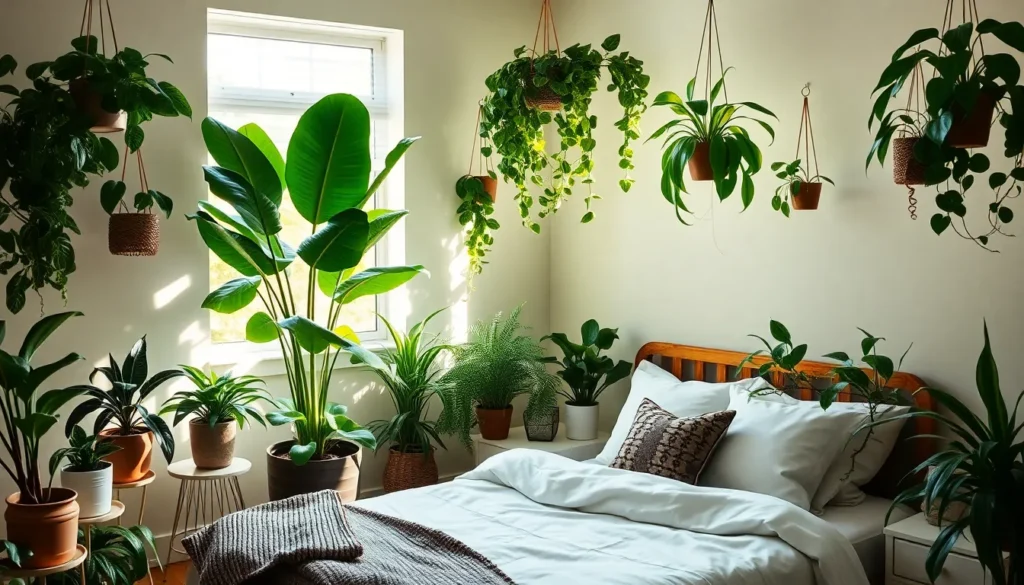We’ve all dreamed of waking up in a lush green sanctuary where nature meets comfort. A bedroom filled with plants isn’t just Instagram-worthy – it’s a game-changer for your sleep quality and overall well-being. Transform your personal space into an oxygen-rich oasis that purifies the air while you rest.
Creating a plant-filled bedroom offers incredible benefits beyond aesthetics. We’re talking about improved air quality natural humidity regulation and a calming atmosphere that promotes deeper sleep. Studies show that certain plants can remove harmful toxins from indoor air while releasing fresh oxygen throughout the night.
The best part? You don’t need a green thumb to create this botanical paradise. We’ll show you exactly how to choose the right plants arrange them for maximum impact and maintain your green bedroom sanctuary with minimal effort. Get ready to wake up refreshed in your very own indoor jungle.
Transform Your Sleep Space Into a Green Oasis
Creating your bedroom plant sanctuary starts with strategic placement around your sleeping area. Position larger plants like fiddle leaf figs or monstera deliciosa in corners where they’ll receive indirect light while making a bold visual statement. Floor space near windows becomes prime real estate for these statement pieces that anchor your green design.
Nightstand surfaces offer perfect spots for smaller specimens such as pothos, snake plants, or peace lilies that won’t overwhelm your bedside essentials. These compact companions provide air purifying benefits within arm’s reach of where you sleep most peacefully.
Hanging planters maximize vertical space without cluttering your floor or furniture surfaces. Macrame holders suspended from ceiling hooks showcase trailing varieties like string of hearts or English ivy that cascade beautifully above your bed.
Window sills accommodate sun loving plants including small succulents, herbs, or flowering varieties that thrive in natural light exposure. South facing windows particularly suit plants requiring brighter conditions while still maintaining your sleep space aesthetics.
Dresser tops and shelving units create multi level displays using plants of varying heights and textures. Combine upright growers like ZZ plants with sprawling varieties such as spider plants to establish visual depth throughout your bedroom sanctuary.
Wall mounted planters save valuable floor space while adding living artwork to blank bedroom walls. These vertical gardens work especially well for air plants, small ferns, or trailing succulents that don’t require frequent watering access.
Corner plant stands elevate smaller specimens to eye level where their foliage becomes more prominent in your daily view. Bamboo or wooden stands complement natural bedroom decor while providing proper drainage underneath each pot.
Bathroom adjacent bedrooms benefit from humidity loving plants like Boston ferns or orchids placed near doorways where they’ll receive moisture from shower steam. This placement strategy naturally regulates your bedroom’s humidity levels for optimal sleep comfort.
Choose Low-Light Plants That Thrive in Bedroom Conditions
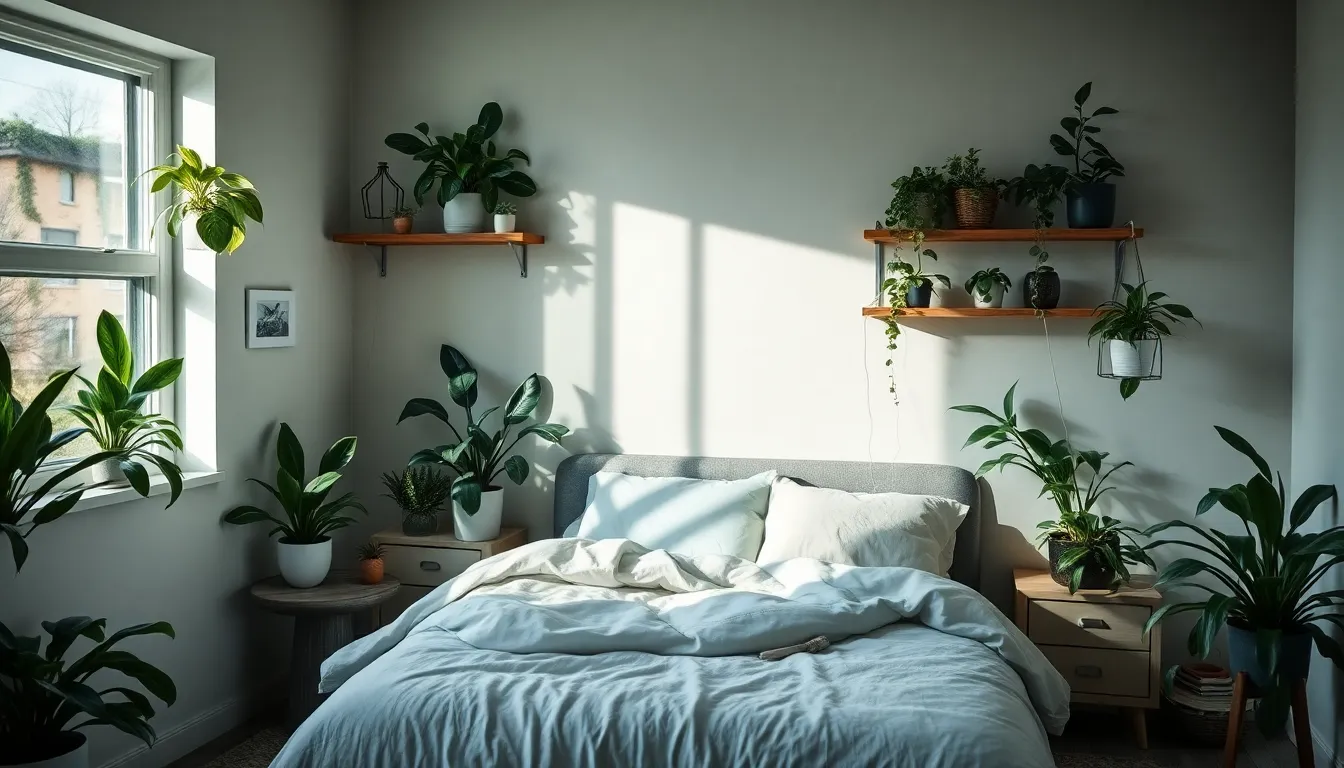
Most bedrooms receive limited natural light, making plant selection crucial for success. We’ve identified the best low-light tolerant varieties that’ll transform your bedroom into a thriving green sanctuary.
Snake Plants for Air Purification
Sansevieria plants stand out as the ultimate bedroom companion for air quality improvement. These resilient beauties filter indoor toxins while you sleep, creating a healthier bedroom environment that promotes better rest.
Sword-like leaves with striking variegated patterns make snake plants visually appealing additions to any bedroom decor. Their upright growth habit works perfectly beside dressers or in corners where other plants might struggle.
Busy lifestyles don’t phase these hardy plants since they tolerate infrequent watering and very low light conditions. We recommend snake plants for anyone wanting maximum air purification benefits with minimal maintenance effort.
Pothos for Easy Care and Growth
Epipremnum aureum delivers exceptional beauty with virtually zero fuss in bedroom environments. Quick growing vines cascade beautifully from shelves or hanging planters, adding instant lushness to your sleeping space.
Trailing growth patterns create stunning visual displays when pothos plants spill over nightstands or bookcases. Their heart-shaped leaves catch whatever light is available, making them perfect for dimly lit bedrooms.
Dry air and irregular watering schedules won’t harm these adaptable plants, making them ideal for bedrooms with varying humidity levels. We love how pothos plants forgive neglect while still providing gorgeous greenery.
ZZ Plants for Dark Corner Spaces
Zamioculcas zamiifolia excels in the darkest bedroom corners where most plants would fail. These contemporary looking plants bring life to spaces that typically remain bare due to poor lighting conditions.
Waxy, dark green leaves create a polished, modern aesthetic that complements minimalist bedroom designs. Their compact growth habit fits perfectly in tight spaces without overwhelming smaller bedrooms.
Drought tolerance makes ZZ plants practically indestructible, requiring attention only when you remember to check on them. We consider these plants essential for anyone wanting bedroom greenery without the commitment of regular plant care.
Create Vertical Plant Displays to Maximize Floor Space
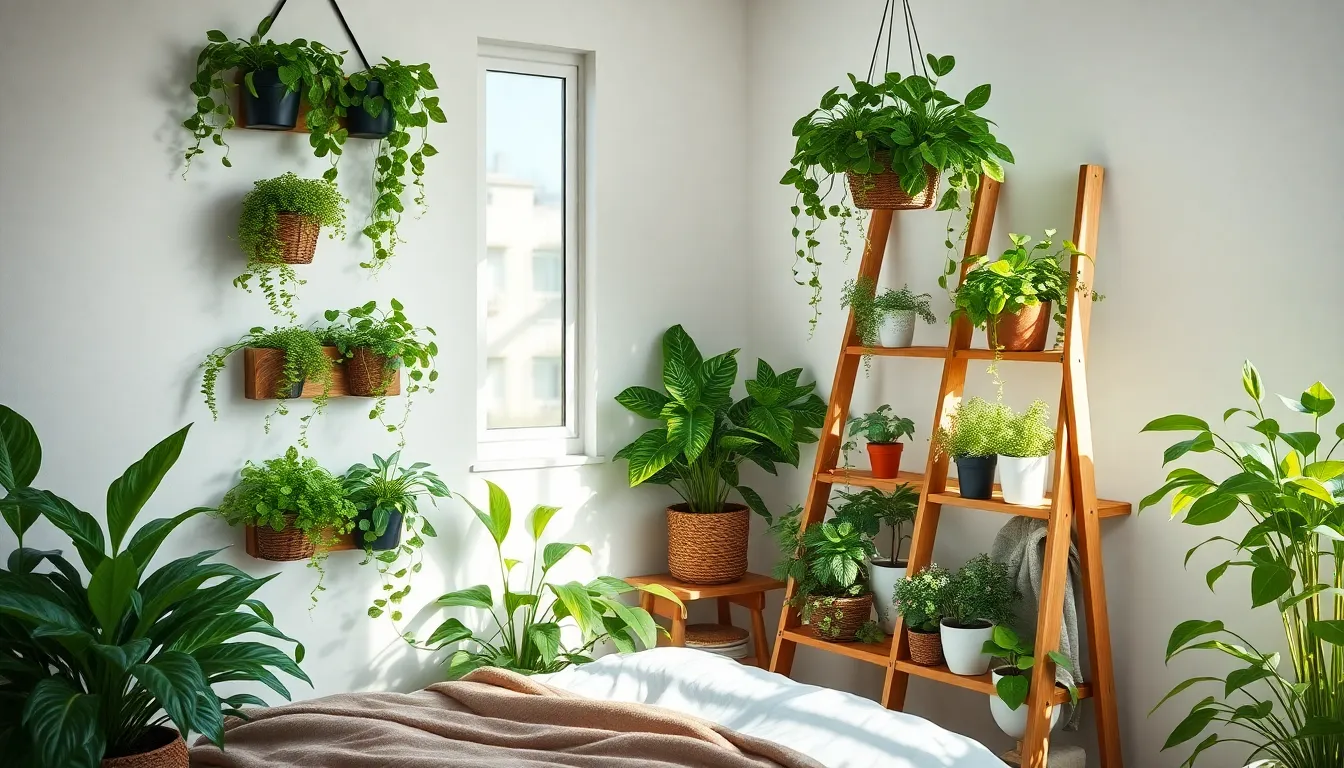
When we’re dealing with limited bedroom space, vertical gardening becomes our best friend for creating that lush plant sanctuary. We can grow many plants by utilizing walls and vertical surfaces while improving air circulation and plant health.
Wall-Mounted Planters and Shelving Systems
Wall-mounted planters provide the most striking way to display our plant collection without sacrificing precious floor area. Floating shelves or bracket-mounted platforms can hold various small to medium-sized potted plants, creating living artwork on our bedroom walls. We’ll find that hanging garden shelves suspended by ropes or cords form beautiful tiered displays that combine aesthetics with functionality.
These systems work particularly well in minimalist, rustic, or boho-themed bedrooms and can support lightweight to medium pots. Bracket systems allow us to adjust shelf heights as our plants grow, while rope-suspended shelves add texture and visual interest to the room.
Hanging Baskets from Ceiling Hooks
Hanging baskets create a floating garden effect that adds greenery overhead while freeing up even more valuable floor space. We can achieve this stunning visual by attaching baskets to ceiling hooks, allowing plants to cascade down and enhance our room’s ambience naturally.
This method improves natural light exposure for our plants due to their elevated positioning. Trailing plants like pothos and spider plants thrive in hanging displays, creating beautiful cascading effects that draw the eye upward and make our bedroom feel larger.
Ladder Plant Stands for Layered Height
Ladder-style plant stands offer multiple tiers of plant display that stack vertically, adding depth and dimension to our bedroom greenery. These stands complement our wall-mounted shelves and hanging baskets by creating layered height visual interest throughout the space.
We can easily move and rearrange ladder stands as needed, making them perfect for experimenting with different plant arrangements. Plants with shallow roots such as herbs and small flowering plants thrive in these vertical arrangements, making them ideal additions to our bedroom plant displays.
Position Plants Strategically for Optimal Growth and Aesthetics
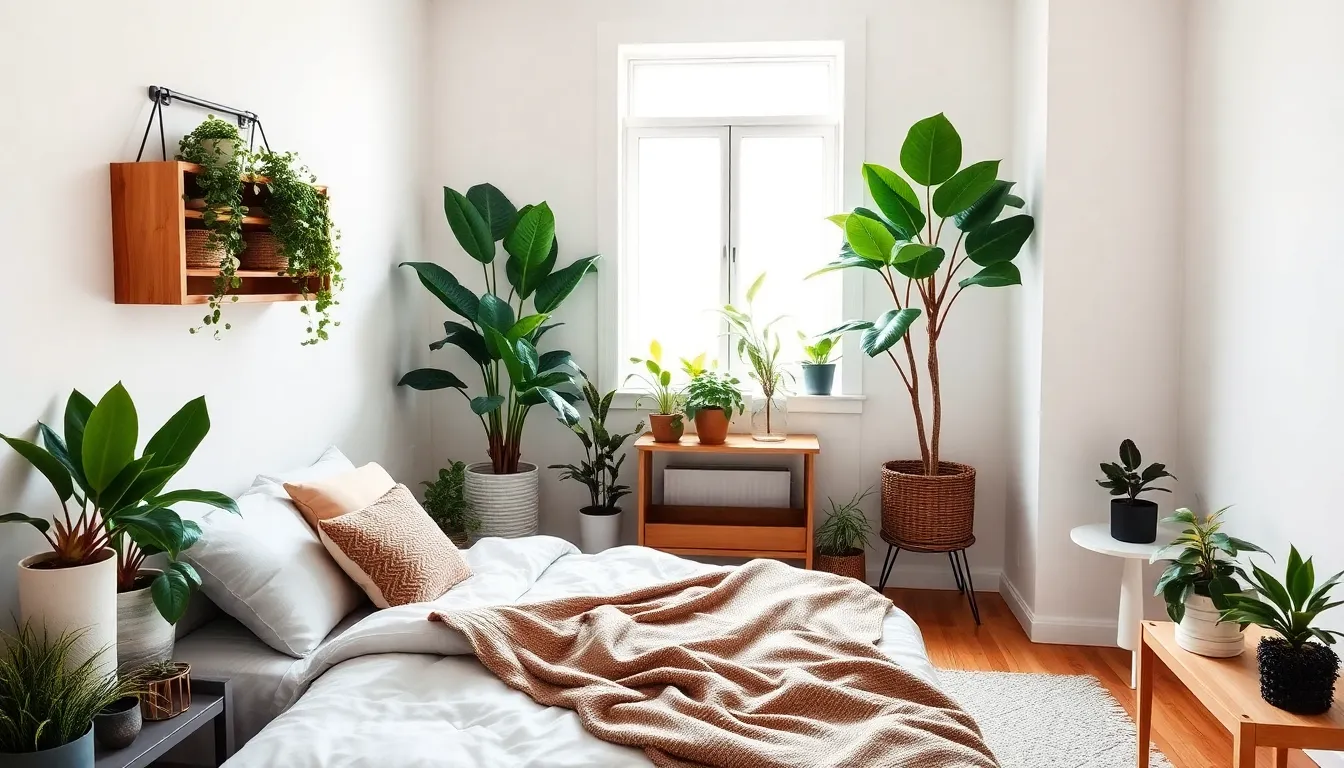
Strategic placement ensures our plants receive proper light while improving the bedroom’s visual appeal. We’ll transform our space by positioning plants in three key areas that maximize both their health and aesthetic impact.
Near Windows for Natural Light Access
Eastern exposure windows provide the perfect lighting conditions for most indoor plants in our bedrooms. These windows deliver bright, indirect morning light without excessive heat, helping our plants thrive while minimizing water loss. We recommend placing light-loving plants near these windows to take advantage of the gentle morning sun.
Southern and western windows can also work well for our plant collection, though we need to filter harsh direct sunlight to prevent leaf damage. We can use sheer curtains or position plants slightly away from these windows to create the ideal lighting conditions. This strategic placement ensures our plants receive essential natural light for optimal growth while protecting them from excessive sun exposure.
Around the Bed Frame for Visual Balance
Small plants on bedside tables create an instantly calming atmosphere while adding essential greenery to our sleeping space. Succulents and ferns work particularly well in these spots because they don’t take up much room and foster relaxation through their peaceful presence. We can select compact varieties that complement our bedroom’s scale without overwhelming the nightstand space.
Hanging plants and taller specimens positioned near the bed provide eye-level greenery that creates a layered, natural look. These plants help balance the room visually by adding height and depth around our sleeping area. We’ll achieve the most impact by varying plant heights and textures to create visual interest throughout the bedroom.
In Empty Corners to Fill Dead Space
Larger plants like Fiddle Leaf Figs and Rubber Trees excel in corner positions where they serve as striking focal points. These substantial plants fill underutilized spaces while adding dramatic height and presence to our bedroom design. We can choose specimens that complement our room’s proportions and create visual weight in these otherwise empty areas.
Plant stands and decorative pots enhance the corner placement by adding extra height and style to our displays. We recommend selecting stands that match our bedroom’s aesthetic, whether that’s sleek metal for modern spaces or natural wood for bohemian vibes. This approach allows us to layer plants at different heights while creating dimension that mimics natural environments.
Select Stylish Planters That Complement Your Bedroom Decor
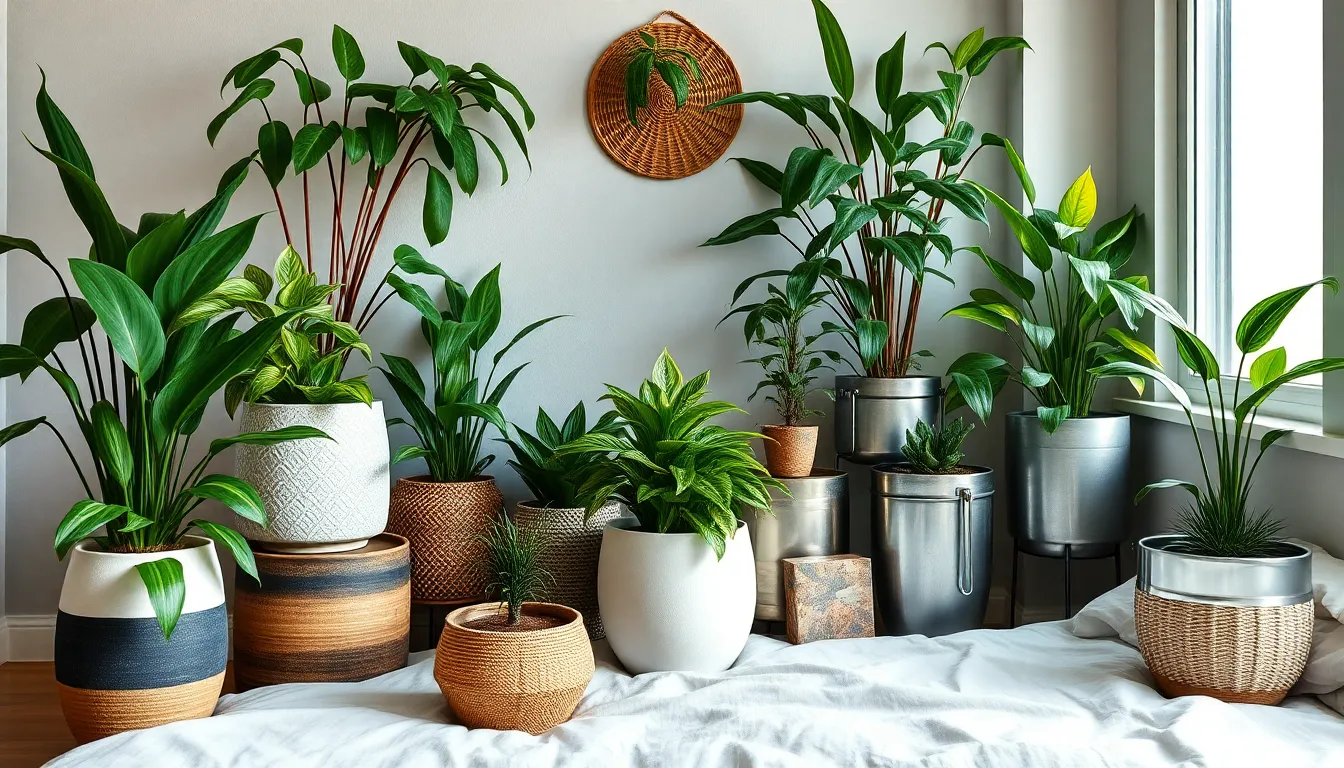
We can transform any bedroom into a cohesive botanical sanctuary by choosing planters that align with our existing decor style. The right planter selection creates visual harmony between our plants and bedroom aesthetic, making the space feel intentionally designed rather than randomly filled with greenery.
Ceramic Pots for Modern Minimalist Looks
Ceramic pots deliver the sleek, clean lines that modern minimalist bedrooms demand. We find these planters particularly effective because their smooth textures and solid forms enhance the simplicity and order typical in minimalist spaces. Bold colors work beautifully for statement pieces, while muted tones like white, gray, and beige seamlessly blend with neutral bedroom palettes.
Geometric shapes in ceramic planters add visual interest without overwhelming minimalist design principles. We recommend pairing ceramic pots with low maintenance plants like snake plants or ZZ plants, which complement the structured aesthetic. These planters work exceptionally well on clean surfaces like floating nightstands or modern dressers, where their refined appearance can shine.
Woven Baskets for Boho Bedroom Vibes
Woven baskets bring the warmth and natural textures that bohemian inspired bedrooms crave. These planters soften the greenery’s appearance while adding a cozy, handmade aesthetic that perfectly complements eclectic, earthy bedroom elements. Natural materials like seagrass, jute, and rattan create the authentic boho feel we’re after.
Varying basket sizes and weaving patterns adds visual depth to our plant displays. We particularly love using woven baskets for larger floor plants like parlor palms or corn plants, where the natural texture creates a beautiful contrast against colorful textiles and vintage furniture. These planters hide plastic pots beautifully while maintaining the organic, lived in vibe that defines bohemian style.
Metallic Planters for Industrial Style Rooms
Metallic planters in copper, brass, or black metal finishes perfectly suit industrial bedrooms featuring raw materials like exposed brick and reclaimed wood. Their reflective surfaces add an edgy, contemporary touch that enhances the urban aesthetic we want to achieve. These planters create striking focal points against darker industrial backdrops.
Black metal planters work particularly well with trailing plants like golden pothos, creating dramatic contrasts in industrial spaces. We find copper and brass finishes add warmth to cooler industrial elements while maintaining the modern edge. These metallic planters look stunning on metal shelving units or concrete surfaces, where their industrial materials create a cohesive design story throughout the bedroom.
Maintain Proper Humidity and Watering Schedules
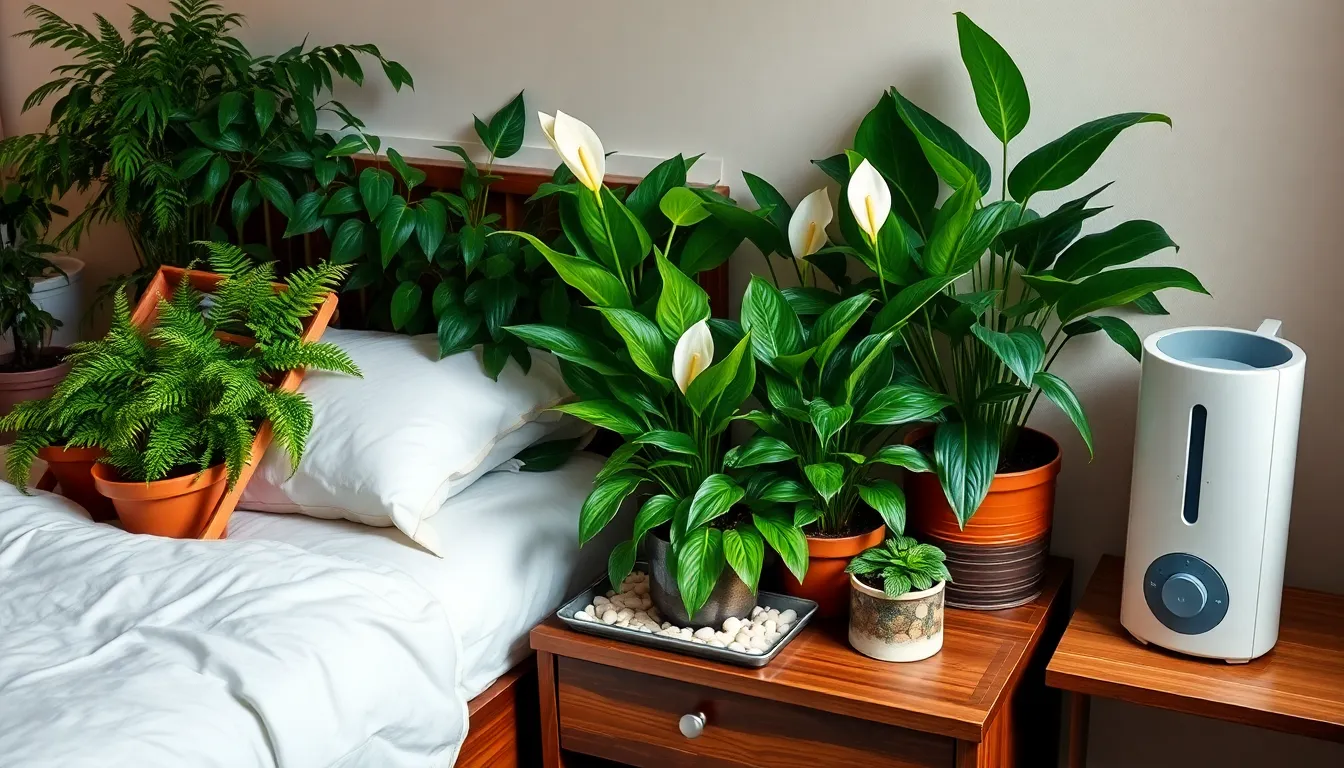
Creating a bedroom with lots of plants requires careful attention to moisture levels and watering schedules to ensure our green companions thrive indoors. Research shows that most indoor plants flourish in humidity levels between 30-50%, making proper moisture management essential for a healthy plant bedroom environment.
Group Plants Together for Increased Moisture
Grouping plants closely encourages shared transpiration, creating a natural microclimate that benefits moisture-sensitive varieties. When we place multiple plants near each other, they release water vapor through their leaves, increasing local humidity around the entire collection. This natural process works especially well in bedrooms where humidity levels can drop significantly due to heating and air conditioning systems.
Strategic clustering also makes our plant care routine more efficient while maximizing the humidity benefits. Plants like Boston ferns and peace lilies particularly benefit from this grouping method, as they require higher moisture levels than typical bedroom conditions provide. We can arrange different sized plants together, with taller specimens providing shelter for smaller ones while all contributing to the shared humid environment.
Use Pebble Trays and Humidifiers
Pebble trays offer an immediate solution for raising humidity without risking root rot from overwatering. We fill shallow trays with water and pebbles, then place our plant pots on top, ensuring the bottom doesn’t touch the water directly. As water evaporates from these trays, it creates localized humidity that benefits nearby plants without saturating the soil.
Ultrasonic or evaporative humidifiers provide consistent moisture control, especially in dry climates or air-conditioned rooms. Automated humidifiers with built-in sensors optimize moisture levels throughout the day, adapting to fluctuating indoor conditions that naturally occur in bedroom environments. We recommend positioning humidifiers near our plant groupings to maximize their effectiveness while maintaining the 30-50% humidity range that promotes healthy growth.
Establish Weekly Watering Routines
Weekly watering schedules customized to plant type and season prevent both overwatering and drought stress in our bedroom plant collections. Morning watering allows better absorption and reduces fungal problems that can develop when moisture sits on leaves overnight. We should always check soil moisture before watering, as bedroom plants typically require less frequent watering than those in brighter, warmer locations.
Proper drainage becomes crucial when maintaining multiple plants in bedroom settings where air circulation may be limited. We ensure all our pots have drainage holes and use well-draining potting mix to prevent water from accumulating around roots. Monitoring our plants with hygrometers helps us track humidity levels and adjust our watering frequency based on seasonal changes and indoor climate variations.
Address Common Concerns About Plants in Bedrooms
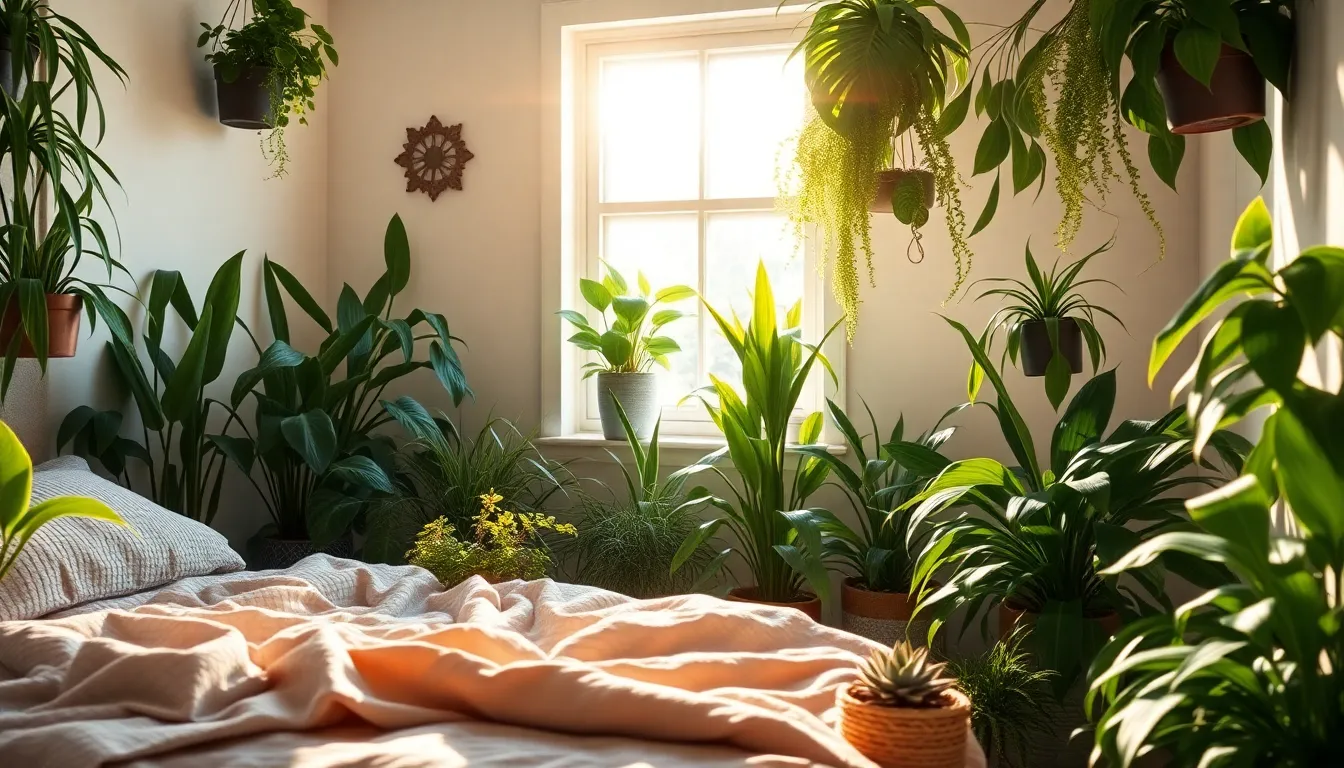
We understand that transforming your bedroom into a plant paradise raises some important questions about safety and practicality.
Nighttime Oxygen Production Myths
Many people worry that bedroom plants will steal oxygen while they sleep, but this concern stems from misunderstanding how photosynthesis works. Most plants absorb carbon dioxide and release oxygen during daylight hours through photosynthesis, then reverse this process at night when sunlight isn’t available.
Snake plants and orchids actually continue releasing oxygen even in darkness, making them exceptional choices for bedroom environments. These unique plants can slightly improve your air quality throughout the night, though the effect remains minimal unless you have hundreds of plants in your space.
We need to address the popular misconception that houseplants dramatically purify indoor air. Research shows that plants’ air-cleaning effects are practically negligible in typical home settings, requiring around hundreds of plants per room to make any meaningful difference in air quality.
Allergy Considerations and Plant Selection
Houseplants generally benefit most people’s health when kept in reasonable numbers, but we should consider potential allergy triggers. Soil mold and plant pollen can cause reactions in sensitive individuals, making plant selection crucial for maintaining bedroom comfort.
Choosing low-pollen, non-flowering varieties helps minimize allergy risks while still providing the aesthetic and psychological benefits of greenery. Spider plants, snake plants, and succulents represent excellent low-maintenance options that require minimal watering and create less favorable conditions for mold growth.
Good ventilation and proper soil care further reduce allergen exposure. We recommend checking soil moisture regularly and avoiding overwatering, which creates ideal conditions for mold development that can trigger respiratory issues.
Pet Safety with Toxic Plant Species
Pet owners must carefully research plant toxicity before introducing new greenery into their bedrooms. Common houseplants like philodendrons, pothos, and certain ivy species can cause serious health problems if our furry friends decide to nibble on leaves or stems.
Spider plants and most succulents offer pet-safe alternatives that won’t compromise your animals’ wellbeing. These varieties provide the same visual appeal and low maintenance benefits without the worry of accidental poisoning.
Training pets to avoid plants and positioning potentially harmful varieties out of reach creates additional safety layers. We suggest placing toxic plants on high shelves or in hanging planters where curious cats and dogs can’t access them easily.
Style Your Plant-Filled Bedroom for Instagram-Worthy Results
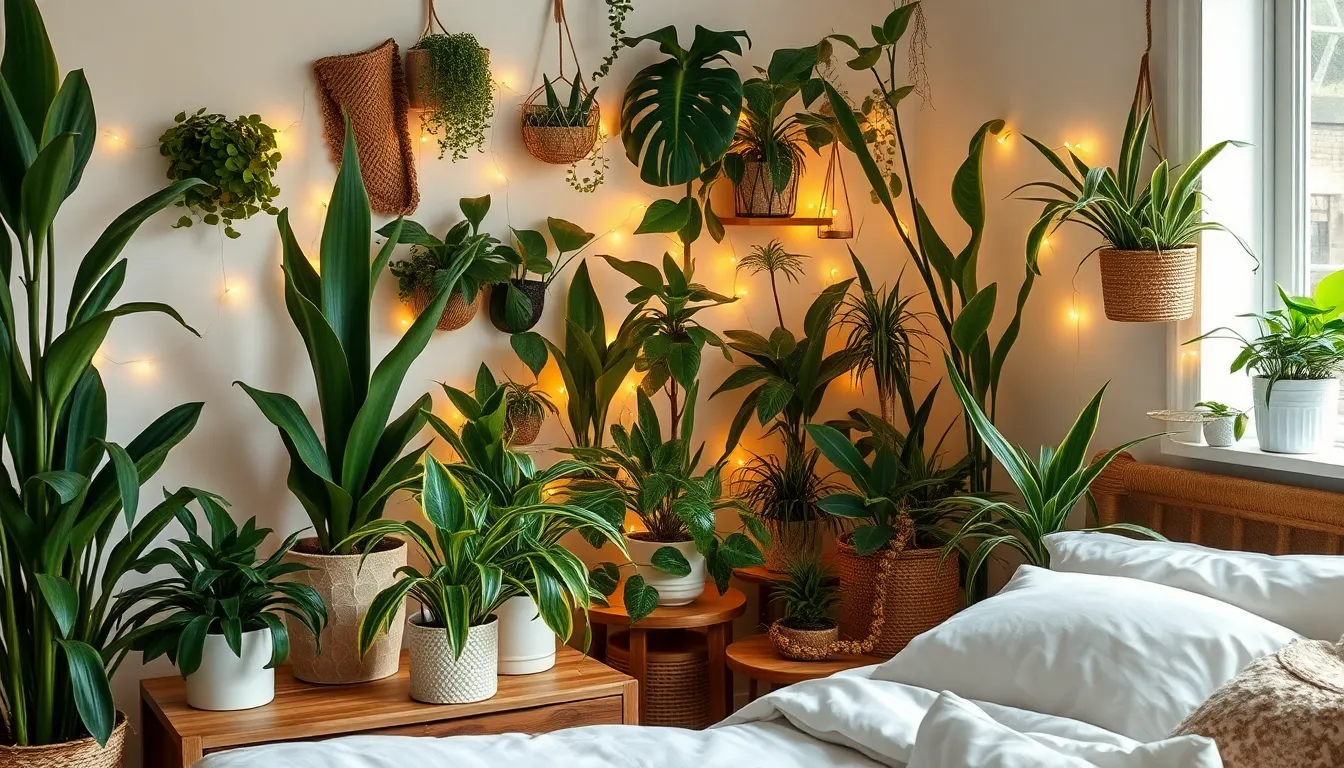
Now that you’ve created your plant sanctuary, let’s transform it into a visually stunning space that’s perfect for sharing on social media. We’ll show you how to arrange your greenery for maximum visual impact and create that coveted Instagram-worthy aesthetic.
Create Focal Points with Statement Plants
Choose one or two large, striking plants as your room’s main attraction. A tall corn plant positioned beside your bedroom door creates an immediate wow factor when you enter the space. Snake plants work beautifully on bedside tables, drawing attention while maintaining that relaxing bedroom vibe we all crave.
Position these statement plants where they’ll anchor your room’s greenery without overwhelming the space. Large floor plants add architectural interest and serve as natural room dividers. We recommend placing them in corners or beside furniture pieces where they can command attention without blocking pathways or creating clutter.
Select plants with bold shapes or dramatic foliage to maximize visual impact. Monstera deliciosa with their iconic split leaves make excellent statement pieces, while tall fiddle leaf figs create elegant vertical lines that enhance your room’s proportions.
Layer Different Plant Sizes and Textures
Combine plants of various heights and leaf textures to add depth and visual softness. Start with large floor plants as your foundation, then add medium-sized potted plants on shelves and dressers. Small plants on bedside tables complete this layered approach and create visual balance throughout your space.
Incorporate hanging plants like neon pothos or lipstick plants to enhance vertical interest. Suspend these trailing beauties from ceiling hooks or place them on elevated shelves above your bed. This technique softens harsh angles and creates that inviting, cocoon-like feeling that makes bedrooms so appealing.
Mix different leaf shapes and sizes to create textural contrast. Pair broad-leafed plants with spiky succulents, or combine glossy foliage with matte finishes. This variety keeps your plant display interesting and prevents it from looking monotonous in photos.
Use plant stands and risers to create multiple levels within your display. This technique allows you to showcase more plants in limited space while creating ever-changing visual arrangements that photograph beautifully from any angle.
Add Fairy Lights for Ambient Plant Lighting
Integrate warm fairy lights draped around plants or woven through hanging baskets. This simple addition creates a cozy, magical atmosphere during evening hours and highlights your greenery as a key design feature. The soft glow transforms your plant collection into living art pieces.
Pair fairy lights with earthy colors and natural woven textures throughout your room. This combination complements your plant-themed bedroom perfectly, creating a cohesive aesthetic that feels both relaxing and visually captivating for social media content.
Position lights strategically to illuminate your plants’ best features. Backlighting larger plants creates dramatic silhouettes, while string lights wrapped around smaller plants add sparkle and dimension. We suggest using warm white lights rather than cool tones to maintain that cozy bedroom atmosphere.
Consider battery-operated fairy lights for flexibility in placement. These allow you to highlight plants in areas without nearby electrical outlets and make it easy to rearrange your lighting setup for different moods or photo opportunities.
Conclusion
Creating a plant-filled bedroom sanctuary doesn’t require a green thumb or massive budget – just thoughtful planning and the right plant choices. We’ve shown you how strategic placement low-light varieties and stylish planters can transform your sleeping space into a tranquil oasis that promotes better rest and well-being.
Whether you’re drawn to the dramatic statement of a tall snake plant or the gentle cascade of trailing pothos your bedroom can become a personalized retreat that reflects your style. Remember to consider your room’s lighting conditions choose pet-safe options if needed and don’t be afraid to experiment with different arrangements.
Your plant-filled bedroom awaits – start small with one or two varieties and gradually build your indoor jungle as you gain confidence and experience the benefits firsthand.
Frequently Asked Questions
What are the main benefits of having plants in your bedroom?
Plants in bedrooms improve air quality, regulate humidity, and create a calming atmosphere that promotes better sleep. They also add natural beauty and can help reduce stress levels. While the air-purifying effects are minimal in typical home settings, the psychological benefits of being surrounded by greenery contribute significantly to overall well-being and relaxation.
Which plants are best for low-light bedroom conditions?
Snake plants, pothos, and ZZ plants are ideal for bedrooms with limited light. Snake plants are particularly excellent as they release oxygen at night and require minimal care. Pothos offer beautiful trailing vines and are very forgiving, while ZZ plants thrive in dark corners and need very little maintenance, making them perfect for beginners.
How should I arrange plants in my bedroom for the best effect?
Place larger plants like fiddle leaf figs in corners for visual impact, and smaller plants like pothos on nightstands. Use hanging planters for trailing varieties and window sills for sun-loving plants. Create multi-level displays on dressers and shelving units to add depth, and consider wall-mounted planters to save floor space while adding living artwork.
Are there any safety concerns with bedroom plants for pets or allergies?
Yes, research plant toxicity if you have pets. Choose pet-safe options like spider plants and succulents, or keep potentially harmful plants out of reach. For allergies, select low-pollen, non-flowering varieties to minimize risks. Always consider your specific sensitivities and consult with a veterinarian about plant safety if you have pets.
What types of planters work best for bedroom decor?
Choose planters that complement your bedroom style. Ceramic pots work well for modern minimalist looks with their clean lines. Woven baskets add warmth and texture for bohemian vibes. Metallic planters in copper or brass finishes create an edgy appeal for industrial-style rooms. The key is matching the planter style to your existing decor.
How can I maximize plant space in a small bedroom?
Use vertical gardening techniques with wall-mounted planters and shelving systems. Hang baskets from ceiling hooks for a floating garden effect. Ladder-style plant stands add layered height without taking up much floor space. This approach allows you to create striking displays while maintaining functionality and easy movement around your bedroom.
Do plants really produce oxygen at night in bedrooms?
Most plants absorb carbon dioxide and release oxygen during the day, but some like snake plants and orchids continue releasing oxygen at night. However, the amount is minimal and won’t significantly impact air quality in typical bedroom settings. The primary benefits come from the psychological effects of having greenery in your sleeping space.
How do I create an Instagram-worthy plant bedroom aesthetic?
Create focal points with statement plants like tall corn plants or snake plants. Layer different plant sizes and textures for depth, and incorporate hanging plants for vertical interest. Use plant stands and risers for multi-level displays. Add warm white fairy lights around plants to create a cozy atmosphere and highlight their natural beauty.

